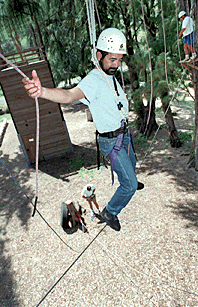Learning the Ropes
by Helen Altonn

GREAT ESCAPE: A gang member takes part in a police exercise at Camp Erdman designed to help change youths' attitudes. Photo by Ken Ige, Star-Bulletin.

GREAT ESCAPE: A gang member takes part in a police exercise at Camp Erdman designed to help change youths' attitudes. Photo by Ken Ige, Star-Bulletin.
"Imagine now, all these rival gang leaders have to work together to accomplish the task," said Sgt. Rodney Goo, head of the gang detail in the police department's Juvenile Crime Prevention Division.
Officers and teachers, whom they distrust, do the same thing, he said. "All of a sudden, they find all these people working with them ...
"It's like a miracle. We watched the kids' attitudes change ... Teachers see the change and want us to do the whole school."
With reports of weapons in schools, Goo said he felt something other than enforcement was needed to deal with gangs.
 So he started the ropes program in September, taking groups of about 26 kids and six adults to Camp Erdman for a day. Youths, who must volunteer for the program, include gang members in school and some outside leaders.
So he started the ropes program in September, taking groups of about 26 kids and six adults to Camp Erdman for a day. Youths, who must volunteer for the program, include gang members in school and some outside leaders."We need to neutralize their feelings toward each other and police, to take them off this macho, gang mentality," Goo said. "They hate us. They need to get over that so we can work with them.
He said they are told they will be arrested if they commit crimes, but threats aren't used to get them to accomplish anything at camp.
After the program, Goo said, "One thing they say to me is, 'Gee, I didn't know police do these kinds of things.' They are always on the other side of the fence."
A professional mediator talks to the youths about nonviolence in school and out of it come agreements by gang members to keep their school safe, Goo said. "They won't have weapons or fights in school."
Catherine Payne, principal of Farrington High School, which has participated in the program, said no major gang incidents have occurred on campus this year.
The school was worried that some off-campus situations might have repercussions on campus, but nothing happened, she said. "Students have been able to respect the school as a place where we want to be safe."
What's missing, Goo said, are follow-up services after the rope experience. He's working with the Office of Youth Services to get youth agencies involved.
"We need somebody in the community to give them a helping hand so they can go to somebody and, if there is a problem, talk to them."
Payne agrees follow-up is critical and says Farrington is trying to provide that.
She said Alison Colby and Sue Tugi, social workers with the Farrington Transition Center, have taken on the gang issue. They've worked with Goo on the ropes program and this year started a student council of gang members, called the "peace council," representing different gangs.
Colby coordinated a session for gang members with a professional mediator at a neutral site, and they agreed the school would be a safe zone, Payne said.
She said peace council members discuss problems and normal school issues. They also identified some schoolwide issues they believe the administration should address, she said.
In the ropes program, Goo said, they have an opportunity "to look inside themselves as to why they're doing this. Most are saying they don't want to get hurt or killed or be pressured into this type of lifestyle...
They write their fears, or reasons for drawing them into a gang, on a 12-foot-by-12-foot pine board, Goo said. Then they break the wood and it's tossed into a bonfire.
The idea, he said, is "to do away with these fears so we can carry on our lives in a normal manner without getting hurt."